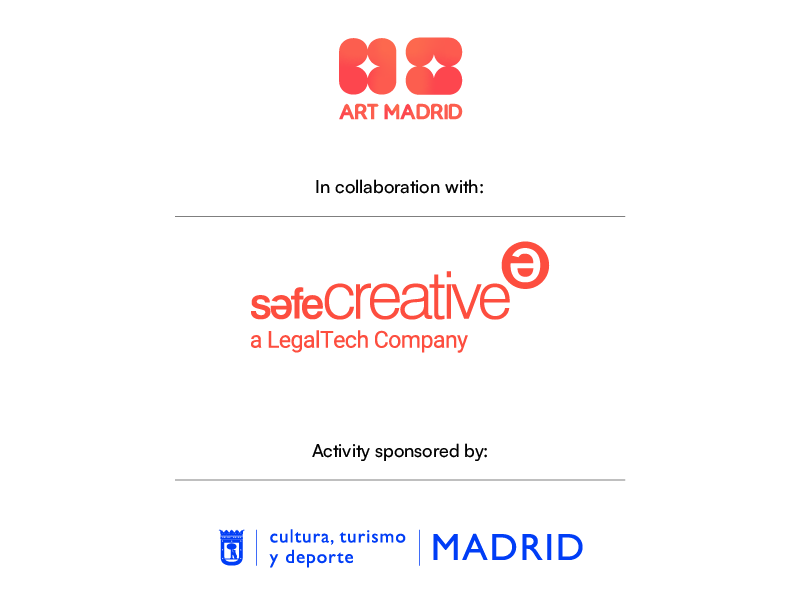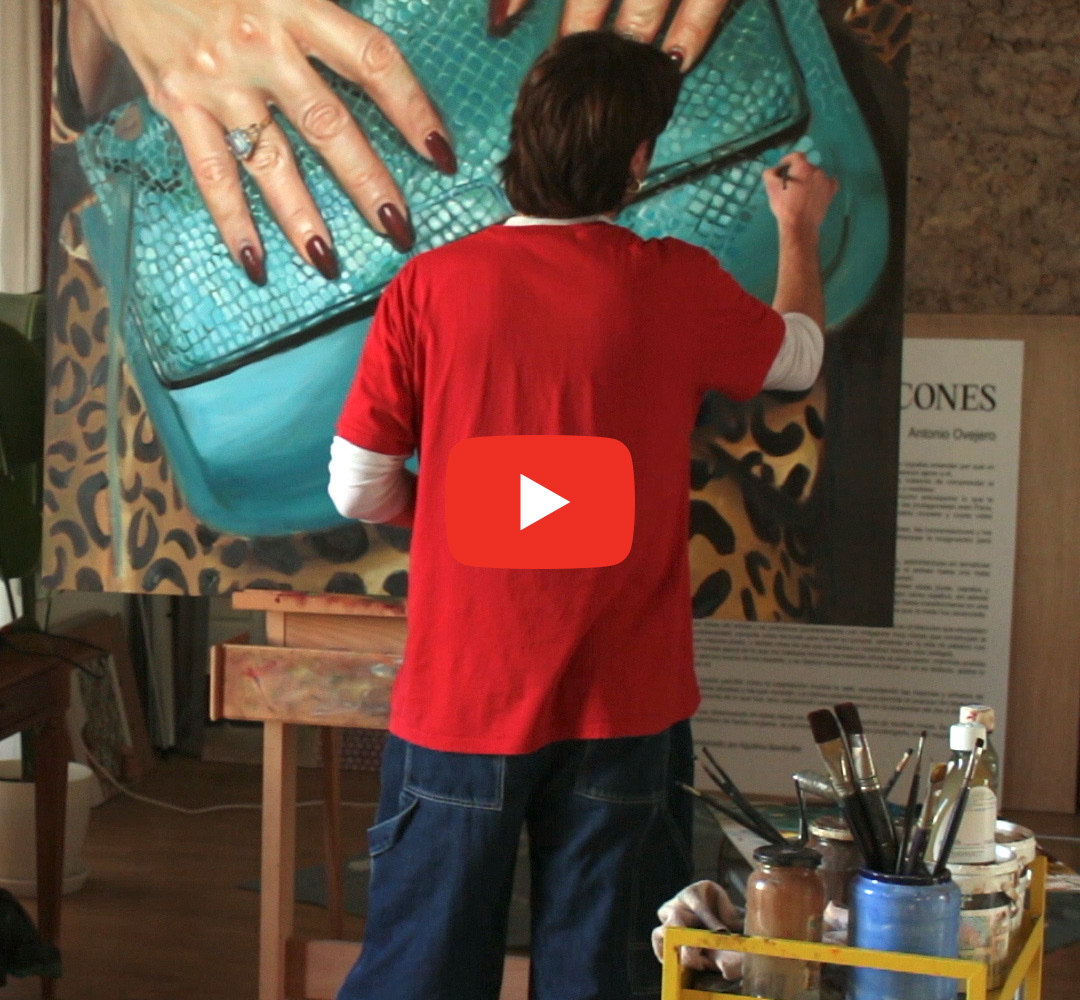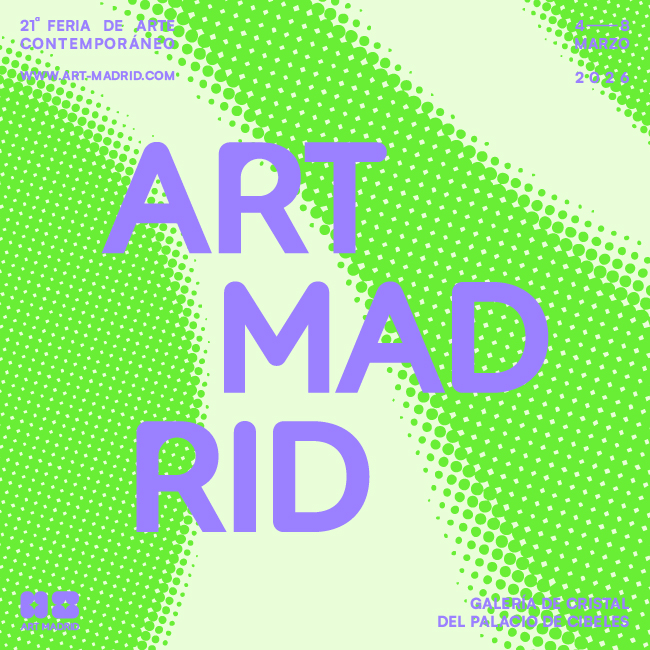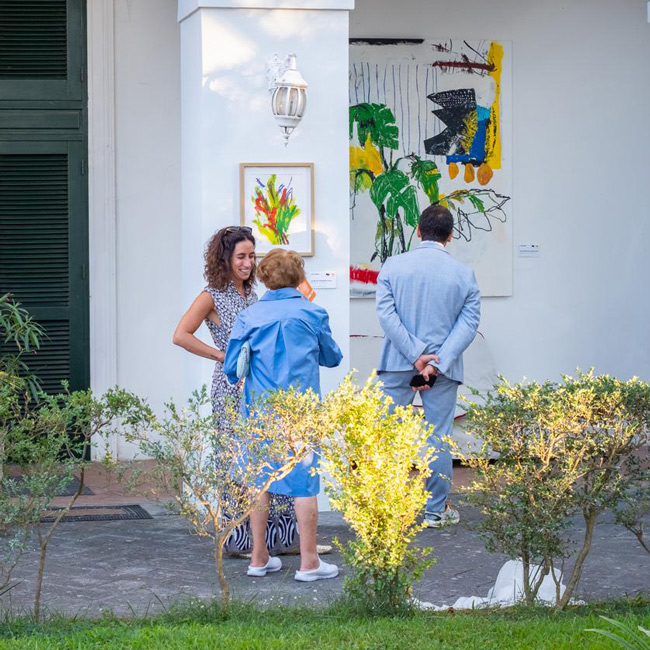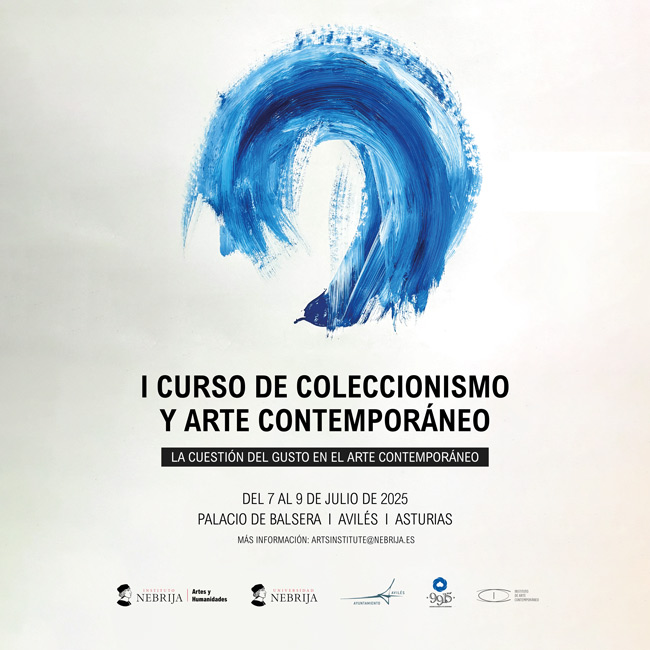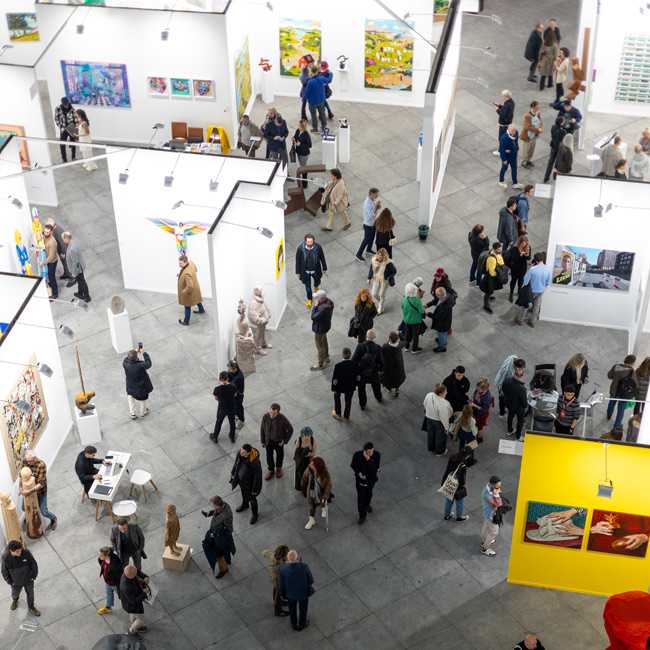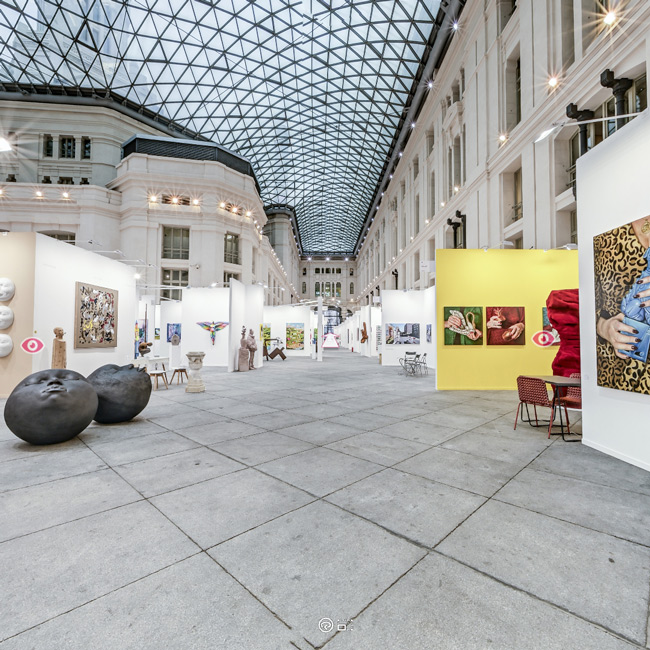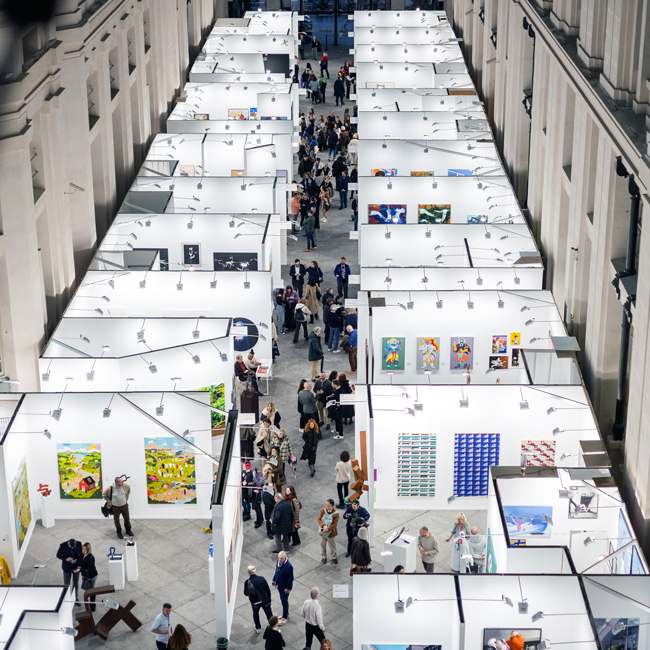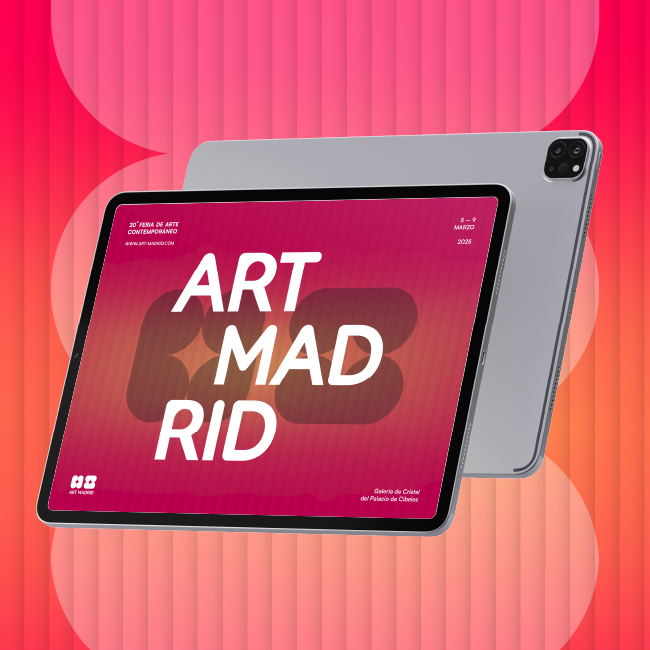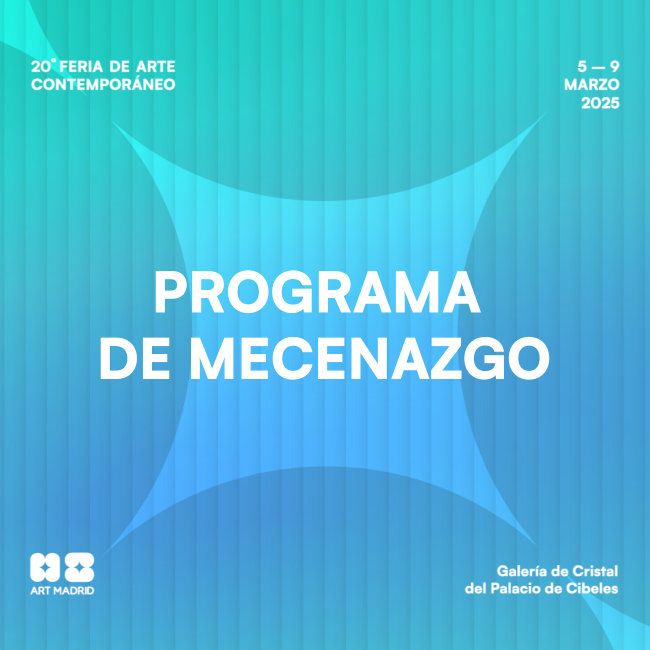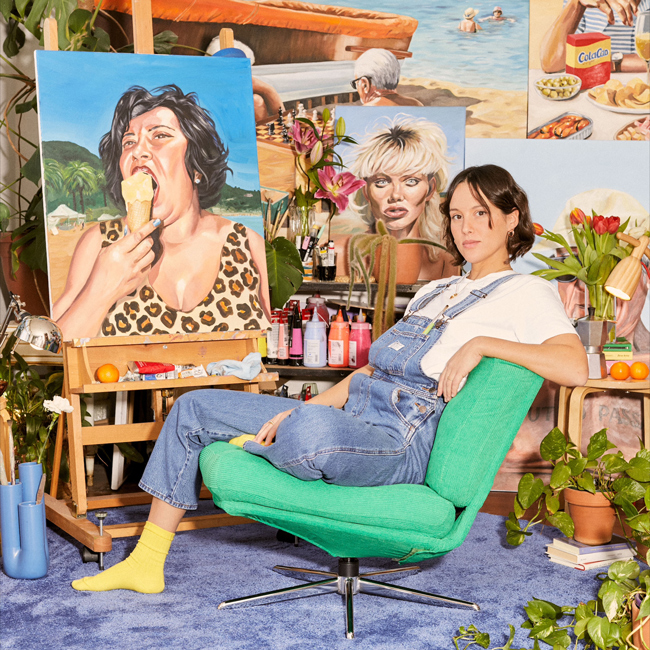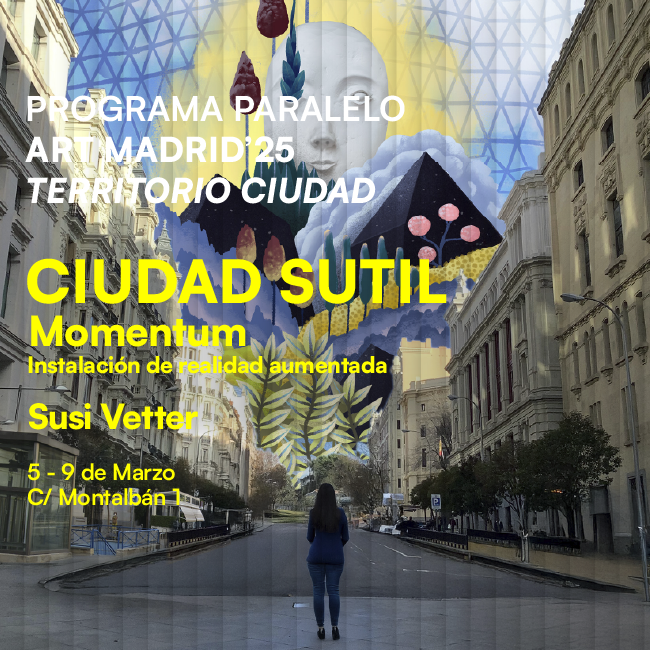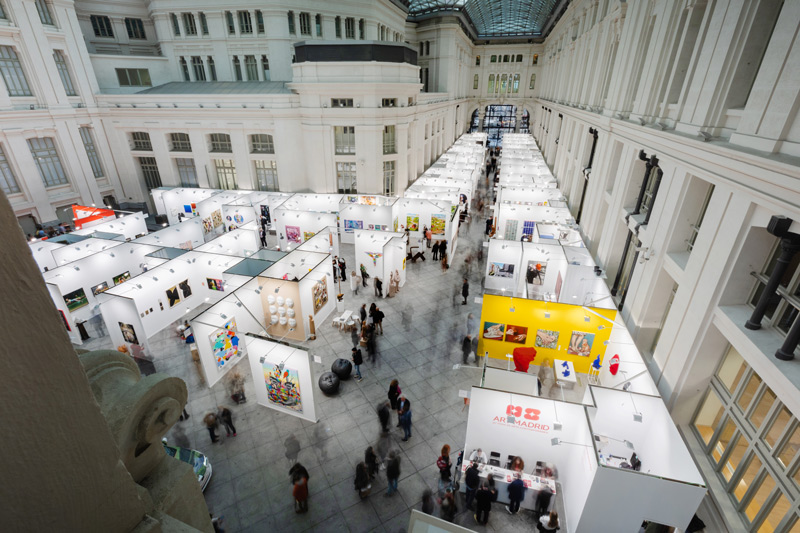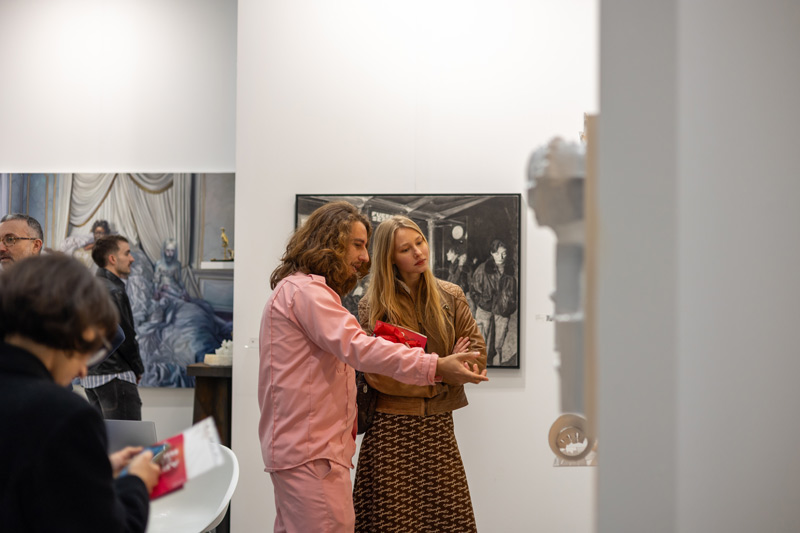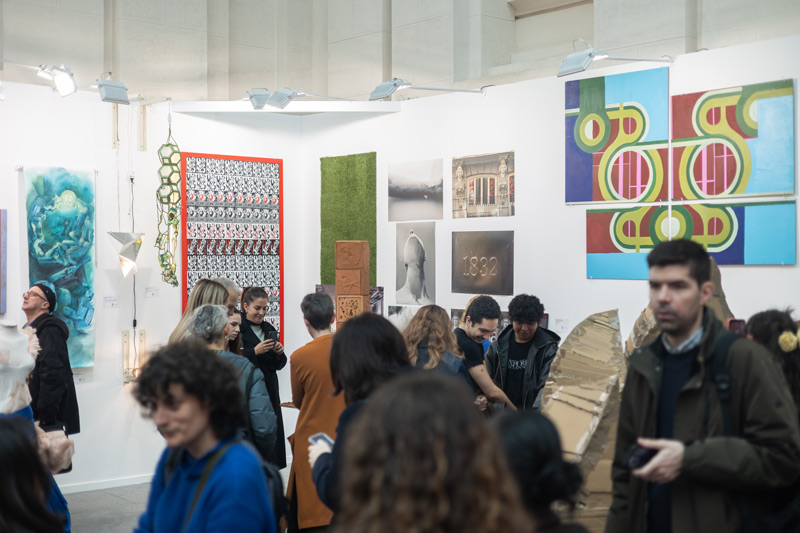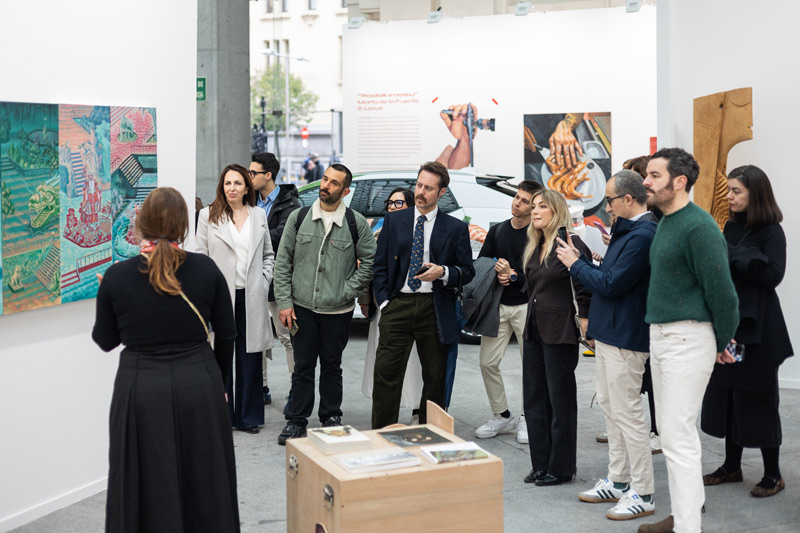ANTONIO OVEJERO: COSTUMBRIST PULSIONS
Jan 15, 2025
art madrid
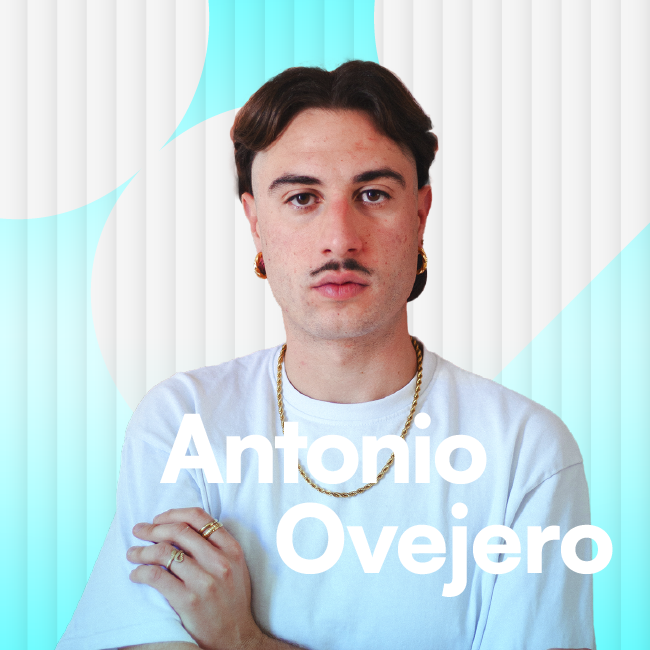
CONVERSATIONS WITH MARISOL SALANOVA. INTERVIEW PROGRAM. ART MADRID'25
Antonio Ovejero (Valencia, 1999) explores memory and the retrieval of scenes that dwell in our collective imagination, focusing on the sublime aspects of everyday life. He is fascinated by women adorned with jewelry and large bags, dresses with geometric patterns, and extravagant hairstyles that bridge different eras. Through a kitsch aesthetic, he seeks the ostentatious in attire, the conspicuous, and the pretentious, elements that are often more common and closer than one might expect.
His portraits often highlight the hands, revealing details and the objects they hold, such as a retro handbag. The use of print as an identity and aesthetic tool is a recurring element in his work. For him, the combination of age, the everyday, and elegance forms a constant image. He defines his pictorial project as a neo-pop costumbrista.
What role does experimentation play in your creative process?
I believe experimentation is crucial for any artist, as it is the means by which you discover how to represent what you wish to convey. Since I began painting, I have used various techniques to achieve the results I was looking for.
Oil painting dominates my work. I've always favored this medium because I feel more comfortable with it, and it delivers the results I want. However, when I decided to incorporate printmaking, I sought ways to present it in a more contemporary manner. Initially, I chose photographic transfer because it seemed like an interesting resource that complemented oil painting well. But I later realized I wanted the work to be entirely plastic, with painting as the dominant element. That’s when I began working with silkscreen, a printing technique that allowed for more precise results and integrated well with oil painting.
For this technique, I used acrylic paint because it dries faster and provides a greater margin for error, although it requires a lengthy process that involves more than just painting. This is when I discovered stenciling, a method where I create designs in Illustrator and then cut them out with a laser cutter. Stenciling makes the painting more organic and faster. So, I continue to search and experiment until I find the right means to complete a painting.
I believe using different techniques within one work greatly enriches it. Currently, I am focused on finding a direct way to combine brushstrokes with prints. I am experimenting with animal prints, which are more organic and forge a direct link between the painting and the act of painting itself.
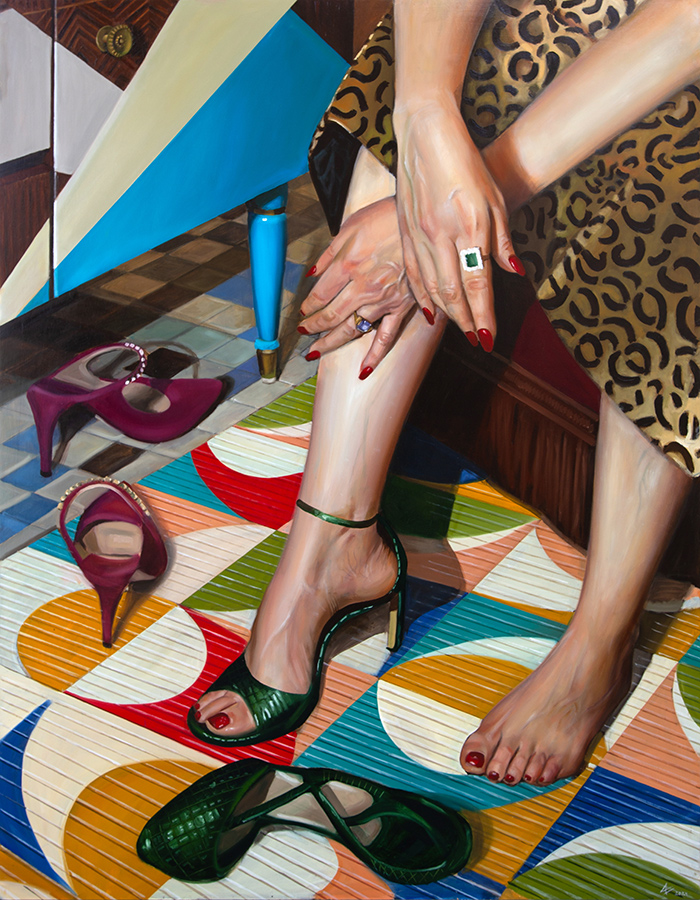
What are your references?
To discuss my references, I think I need to divide them into those within my environment and those from outside. I was born into a family where my father was a painter, and my brother Miguel Ángel is also a painter, so painting has been present since my early years. Additionally, my mother always supported my dedication to the art world, and I spent a lot of time with my grandmother, who was a seamstress. Therefore, anything related to textiles, scraps, and printmaking has always caught my attention, and I have tried to capture it in my work.
As for external references, in painting, I think of artists like Marten Ant and David Storey, who work with photographic archives, or Juan Ugalde, who intervenes in photographs to create new narratives, or Gerhard Richter, whose painting is closely linked to photography. I find the union of photography and painting very interesting. I also think that my work has a strong connection with certain cinematic or photographic influences. In this respect, I highlight Martin Parr, a photographer who captures everyday scenes at the beach, focusing on details like wrinkled hands.
Another reference is Eric Persona, a Milanese photographer who explores daily life from a perspective that blends the extravagant with the mundane, creating very interesting images. I am also inspired by Thandiwe Muriu, a Kenyan photographer who creates images in which prints merge with the model, making prints a symbol of identity for Kenyan women.
As I mentioned earlier, my painting has a close connection to cinema, which is why I always think of Marisa Paredes, especially in Almodóvar’s films, where she portrays a woman with a tough life but remains elegant and sublime, something I try to reflect in the female figures I paint. In this sense, Almodóvar is an important cinematic reference. I also think my work mirrors the interplay of patterns and colors in his films. Another reference is Paolo Sorrentino, an Italian filmmaker who blends the glamorous with the everyday, the extravagant with the costumbrista, concepts I also try to incorporate into my work, just as Fellini captured a strange everydayness.
I believe all these references have a direct influence on me and help me create the imaginary I aim to represent in my work.
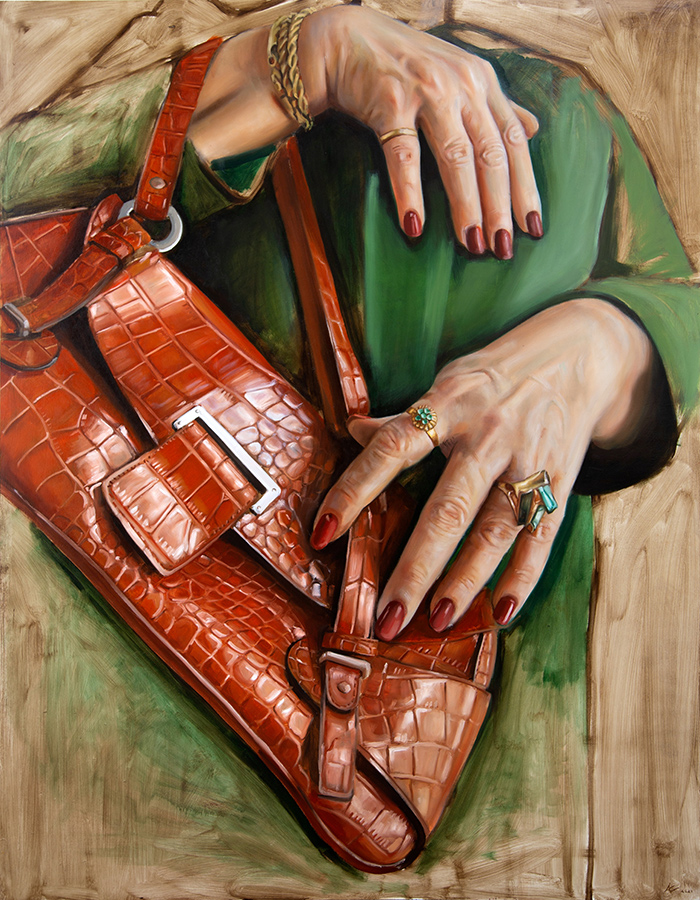
How important is gesture in your portraits?
Throughout my work, I have explored portraiture from various angles, especially in the "Señoras" project, where I wanted to use the portrait as a collective stamp representing the women it portrayed, so that a figure like Conchita or Paca would symbolize all the women of that generation. I think the gesture in the portrait is very important, something I tried to emphasize in my work. Also, depending on how you portray a person, you can convey different things.
For instance, a grimace, a lascivious or defiant look, is also a form of narration within the work. But now, I use portraiture in a different way. I believe that portraying people can also be done by showing the elements that make them up. For example, I now work with close-up shots where elements such as handbags, jewelry, hands, or posture take on great significance. All of these elements also reflect what a person or a group of people is like. So, the current portrait I work on, where I use gestures, relies on the arrangement of elements: how a hand is placed, how a bag is positioned, and how the image I am portraying is constructed.
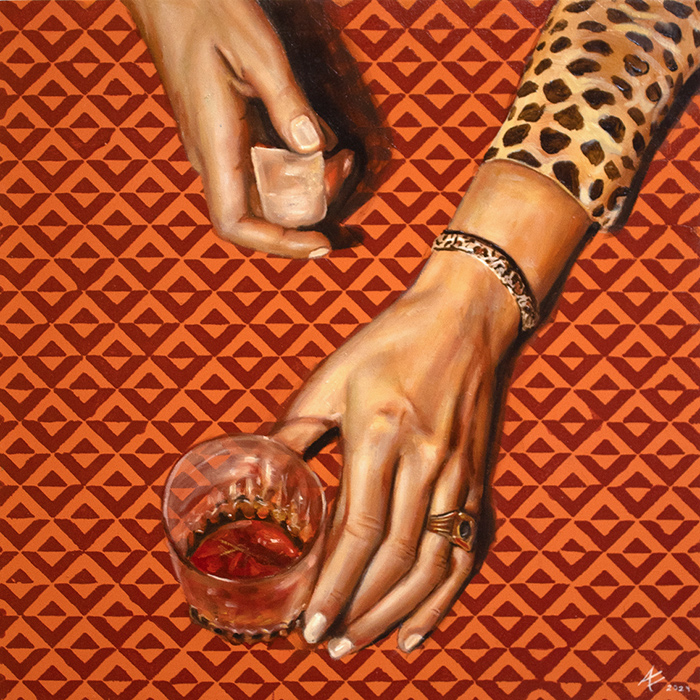
What is your favorite format for painting?
I believe the format is crucial in how you want to create your work and how you work. I almost always work on plywood, on a frame, because the strength of the wood allows me to have more impact on the work. Also, I use printmaking techniques that require a more rigid support; if I used linen or canvas, for instance, it would loosen and make the creative process more challenging. That’s why I always work on wood.
I find it very interesting to use the brush more aggressively in the first strokes, the initial stains, which directly relate to the format. The size of the work is very important. I prefer large formats because I feel freer in that space, where the first brushstrokes and stains feel more satisfying. It also creates a connection between the painting and the act of painting itself, which I believe is essential to creation. I think pleasure has a powerful role in the work, as the result greatly depends on whether there is a certain enjoyment or if you are looking for something more perfectionist or precise.
Large formats allow me to develop best, where the work is constructed and the shapes and brushstrokes merge. When I work with smaller formats, I also enjoy the process, but it requires more consistency and thoroughness. The brushstroke has to be more precise, the focus is on a specific part, and the construction process is slower because the combination of tones is more complex.
On the other hand, in larger formats, the tones and brushstrokes come together more easily, and the form is gradually created as I work. That’s why I generally prefer large formats and plywood.
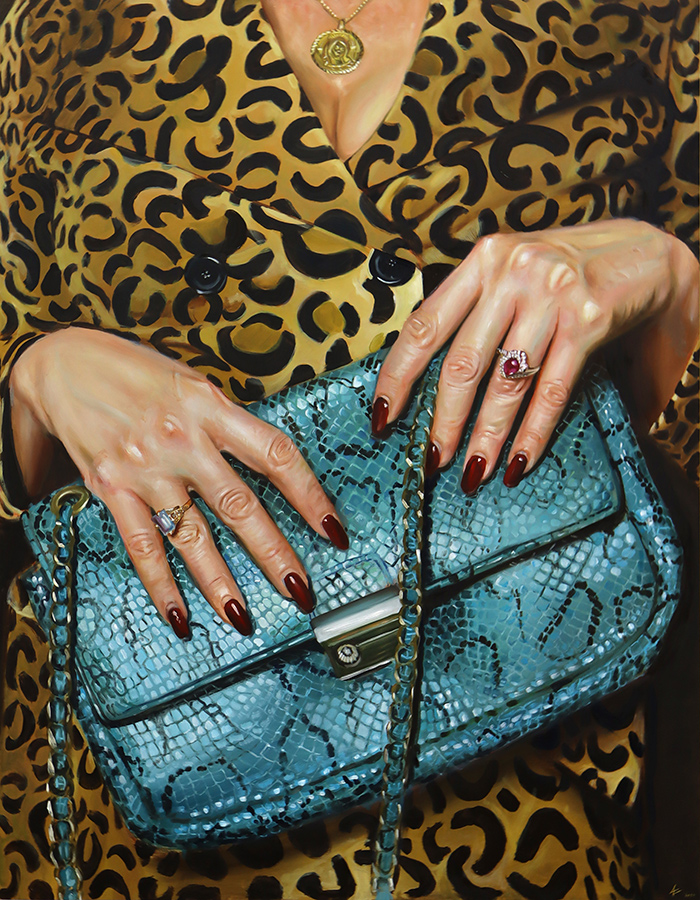
How do you think your works reflect temporality?
In my work, I always try to address themes like memory, the preservation of memory, and the passage of time. Since I began creating, this has been reflected in my first projects such as Mujeres sin color (Women without Color), Relato sobre el luto (Mourning Story), or Señoras (Ladies). I depict elderly women who lived through the post-war era and the cultural and belief systems of Spain at the time, and who, in their maturity, have somehow detached themselves from that past.
That’s why I like to represent them in a more ornate and glamorous way, as a sign of empowerment. For me, it’s important to reflect that resilience through aesthetics and print, which I use as an identity resource for a generation like that of my grandmother and her friends, who came from that harsher Spain but are still present in our society. These women, with their rings, dresses, and handbags, are the women I capture in my work.
I believe that ostentation belongs to the representation of a certain empowerment after a life in black and white, so to speak. Temporality plays a fundamental role in my work. The passage of time and how these people were treated is something I focus on a lot. I try to represent them through their objects or scenes that evoke that era, combining the experiences they have shared with me and those I have lived through, creating a whole imaginary that I seek to capture in my work, centered around these women and this society.
